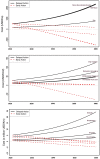Low-cost adaptation options to support green growth in agriculture, water resources, and coastal zones
- PMID: 36284114
- PMCID: PMC9596419
- DOI: 10.1038/s41598-022-22331-9
Low-cost adaptation options to support green growth in agriculture, water resources, and coastal zones
Abstract
The regional climate as it is now and in the future will put pressure on investments in sub-Saharan Africa in water resource management, fisheries, and other crop and livestock production systems. Changes in oceanic characteristics across the Atlantic Ocean will result in remarkable vulnerability of coastal ecology, littorals, and mangroves in the middle of the twenty-first century and beyond. In line with the countries' objectives of creating a green economy that allows reduced greenhouse gas emissions, improved resource efficiency, and prevention of biodiversity loss, we identify the most pressing needs for adaptation and the best adaptation choices that are also clean and affordable. According to empirical data from the field and customized model simulation designs, the cost of these adaptation measures will likely decrease and benefit sustainable green growth in agriculture, water resource management, and coastal ecosystems, as hydroclimatic hazards such as pluviometric and thermal extremes become more common in West Africa. Most of these adaptation options are local and need to be scaled up and operationalized for sustainable development. Governmental sovereign wealth funds, investments from the private sector, and funding from global climate funds can be used to operationalize these adaptation measures. Effective legislation, knowledge transfer, and pertinent collaborations are necessary for their success.
© 2022. The Author(s).
Conflict of interest statement
The authors declare no competing interests.
Figures




Similar articles
-
Climate impacts on European agriculture and water management in the context of adaptation and mitigation--the importance of an integrated approach.Sci Total Environ. 2010 Nov 1;408(23):5667-87. doi: 10.1016/j.scitotenv.2009.05.002. Epub 2009 Jun 5. Sci Total Environ. 2010. PMID: 19501386
-
Global hotspots for coastal ecosystem-based adaptation.PLoS One. 2020 May 29;15(5):e0233005. doi: 10.1371/journal.pone.0233005. eCollection 2020. PLoS One. 2020. PMID: 32469978 Free PMC article.
-
Human and ecosystem health: the environment-agriculture connection in developing countries.J Agromedicine. 1995;2(3):47-64. doi: 10.1300/J096v02n03_06. J Agromedicine. 1995. PMID: 12291328
-
Co-benefits, trade-offs, barriers and policies for greenhouse gas mitigation in the agriculture, forestry and other land use (AFOLU) sector.Glob Chang Biol. 2014 Oct;20(10):3270-90. doi: 10.1111/gcb.12591. Epub 2014 May 8. Glob Chang Biol. 2014. PMID: 24700759 Review.
-
Groundwater dependent ecosystems in coastal Mediterranean regions: Characterization, challenges and management for their protection.Water Res. 2020 Apr 1;172:115461. doi: 10.1016/j.watres.2019.115461. Epub 2020 Jan 2. Water Res. 2020. PMID: 31951946 Review.
Cited by
-
Can multi-agent cooperation promote the ecological value realization of blue carbon in marine ranching?Heliyon. 2023 Jul 22;9(8):e18572. doi: 10.1016/j.heliyon.2023.e18572. eCollection 2023 Aug. Heliyon. 2023. PMID: 37533991 Free PMC article.
-
Modeling of sand-cultivated substrate for Gobi facility agriculture and validation of trenching test.Sci Rep. 2025 Mar 19;15(1):9536. doi: 10.1038/s41598-025-93909-2. Sci Rep. 2025. PMID: 40108269 Free PMC article.
References
-
- IPCC . Climate Change 2022: Impacts, adaptation, and vulnerability. In: Pörtner H-O, Roberts DC, Tignor M, Poloczanska ES, Mintenbeck K, Alegría A, Craig M, Langsdorf S, Löschke S, Möller V, Okem A, Rama B, editors. Contribution of Working Group II to the Sixth Assessment Report of the Intergovernmental Panel on Climate Change. Cambridge University Press; 2022. p. 3056.
-
- Serdeczny O, Adams S, Baarsch F, Coumou D, Robinson A, Hare W, Schaeffer M, Perrette M, Reinhardt J. Climate change impacts in Sub-Saharan Africa: From physical changes to their social repercussions. Reg. Environ. Change. 2017;17(6):1585–1600.
-
- Adegoke J, Sylla MB, Bossa AY, Ogunjobi OK, Adoukpe J. Regional Climate Change Series: Floods. WASCAL; 2019. p. 114.
-
- Taylor CM, Belušić D, Guichard F, Parker DJ, Vischel T, Bock O, Harris PP, Janicot S, Klein C, Panthou G. Frequency of extreme Sahelian storms tripled since 1982 in satellite observations. Nature. 2017;544(7651):475–478. - PubMed
-
- Salack S, Saley IA, Lawson NZ, Zabré I, Daku EK. Scales for rating heavy rainfall events in the West African Sahel. Weather Clim. Extremes. 2018;21:36–42.
Publication types
MeSH terms
Substances
LinkOut - more resources
Full Text Sources

